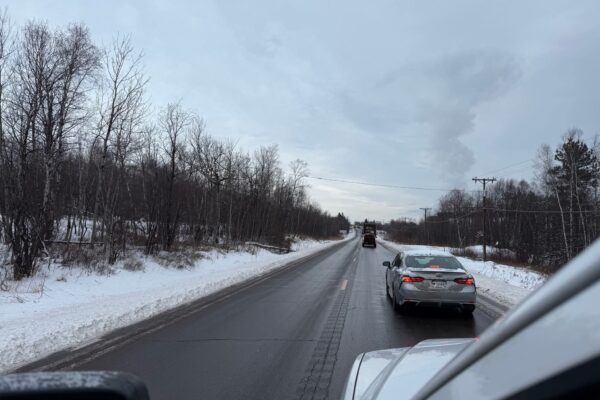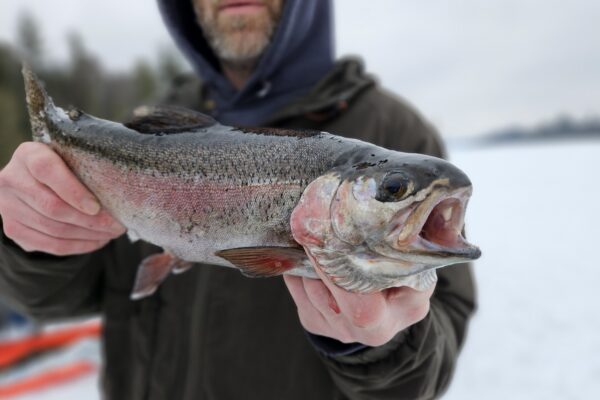Bacteria and pheromones used to check invasive spongy moth population
Spongy moths have been slowly spreading across North American since they were brought to the continent in the late 1800s. The summer season each year includes efforts by the Minnesota Department of Agriculture (MDA) to manage the population in Minnesota, and slow the spread of the invasive species. Danielle DeVito is a pest mitigation and regulatory coordinator for the MDA. She spoke with WTIP about her work to help manage the spongy moth population across the state, and especially Northern Minnesota.
DeVito explained what kinds of issues spongy moths can cause in a forest. She said that a single egg mass can contain 500-1000 eggs, so when the caterpillars hatch, they can quickly cause damage to trees. She said, “Unfortunately, spongy moths will feed on up to 300 different varieties of trees. And it does have some of its favorites. It likes our hardwood trees. It really prefers the oak, the aspen, paper birch basswood. However, in the event they feed out all the leaves off of those species, they will feed on some of our evergreens.”
Replacing leaves requires a tree to expend a lot of energy. DeVito said that, usually, a single year of defoliation won’t kill a tree. She added, however, that “multiple years of really stressing those trees out starts to leave them susceptible to other pests or other diseases and can start to cause mortality on these trees.”
The MDA has been monitoring the spongy moth population since 1973, and actively managing the spread since the 1980s. DeVito said that about 20,000 traps will be set this year as part of surveying the population. The traps are baited with pheromones to attract male moths. Getting a count on the number of males in an area is a way to get an idea of how large a population is, and DeVito said that her office uses the information to decide which areas to target with more specific population management.
Seven Minnesota counties were identified this year as targets for aerial spraying to manage the spongy moth populations. St. Louis, Carlton, Pine, Chisago, Isanti, Houston, and Fillmore Counties were all selected for aerial spraying this summer. DeVito said that the MDA uses air tractors to apply two products to forest canopies that help to limit the population growth and spread of spongy moths.
The first product, called BTK, is a naturally occurring bacteria in forests. DeVito said that typically it is found in the soil, and fatally disrupts the digestion of spongy moth caterpillars. Because the larvae don’t spend time in the soil, their exposure to it is very limited. By dispersing it through aerial spraying, DeVito said that the MDA is able to apply it to the leaves that the caterpillars eat. She added that BTK is an organic, food-grade product. She said, “So BTK actually has a really proven safety record. It’s safe for people, pets, birds, fish, other insects and bees. And it has been used on more than 200 different food or fiber crops.”
The second product that the MDA is spraying select areas with doesn’t cause mortality in the moths, but it still can contribute to population control. DeVito said that the other product, known as SPLAT, floods an area with female spongy moth pheromones. This makes it difficult for male moths to locate female moths, who cannot fly. In the confusion, reproduction is disrupted. This product, according to DeVito, is organic, made from food-grade materials, and biodegradable.
While spongy moths have been present in Minnesota for decades, DeVito said that the state has managed to avoid full-scale outbreaks. She said that in places as close as Bayfield, WI, there have been major outbreaks that have done significant damage to trees. Though, so far, outbreak status has been avoided in Minnesota, DeVito said that she works with agencies in other states to coordinate efforts and share information, in the event of an outbreak. She said “We will have the resources in the colleagues, in the other knowledge, on some other ways that we can deal with that when we see that kind of impact in the state.”
Lake and Cook Counties have been under quarantine status for spongy moths since 2014. This means that the population is closely monitored, and that movement of common items that transport spongy moths needs extra care. For commercial products this includes working with a pest mitigation and regulatory coordinator, like DeVito, when moving things into or out of a quarantine area.
For individuals, DeVito said thorough examinations of any items that are stored outside is vital before moving them is vital, especially since spongy moths will lay eggs on any number of surfaces. She gave examples like lawn furniture, boating and camping gear, and sports equipment, and said that the MDA website includes guides on how to conduct an inspection.
WTIP’s Kirsten Wisniewski spoke with Pest Mitigation and Regulatory Coordinator Danielle DeVito about the efforts to manage the spongy moth population spread. Audio from that interview is below.














